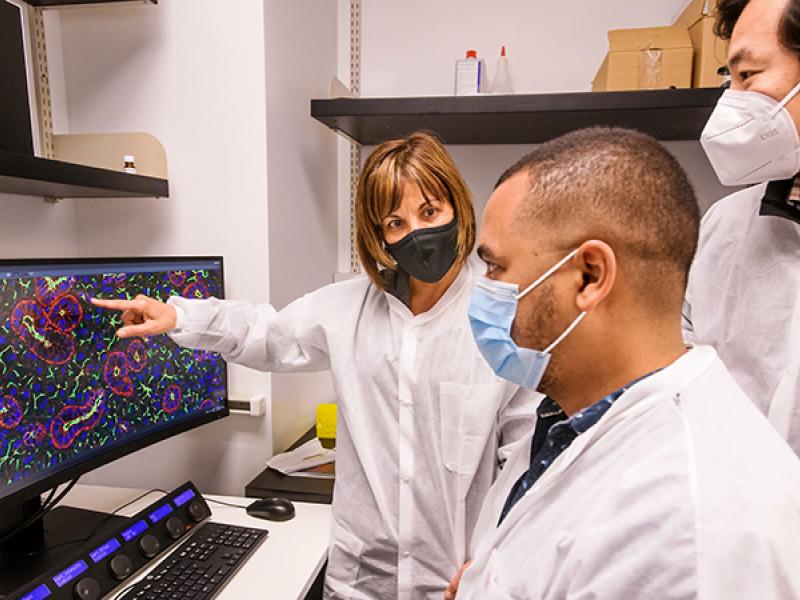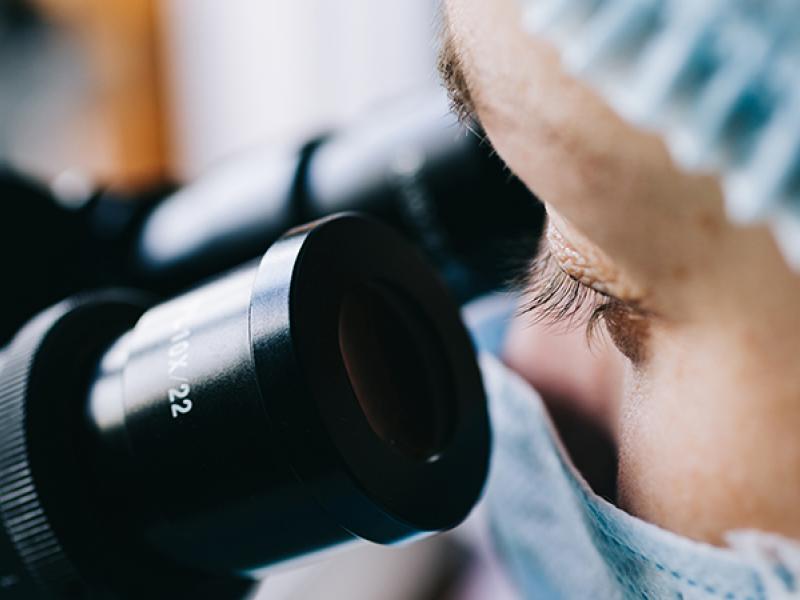Read about research at the MU School of Medicine Department of Otolaryngology - Head and Neck Surgery.
Pharmaceutical Sponsored Clinical Trials
PARADIGHM (Physicians Advancing Disease Knowledge in Hypoparathyroidism): A Natural History Registry for Patients with Chronic Hypoparathyroidism
Robert P. Zitsch, III, M.D. – Site PI
Sponsored by Takeda Development Center Americas, Inc., this clinical trial will characterize the natural history of chronic hypoparathyroidism, including such items as its treatment, clinical outcomes, comorbidity, and mortality in patients, under conditions of normal clinical practice, regardless of disease etiology and management. This study is closed to enrollment.
Assessing Long-Term Outcomes of Dupixent Treatment in Patients with Chronic Rhinosinusitis with Nasal Polyposis (AROMA)
Christine Franzese, MD – Site PI
Sponsored by Regeneron Pharmaceuticals, Inc. The primary objective of this study is to longitudinally characterize the long-term effectiveness of DUPIXENT through assessment of patient-reported symptoms, health-related quality of life (HRQoL) related to chronic rhinosinusitis with nasal polyposis (CRSwNP) and other type 2 comorbidities, and their change over time. In addition the study will characterize patients who receive DUPIXENT for CRSwNP in a real-world setting with respect to their medical history, demographic and disease characteristics, and type 2 comorbidities. Secondary objectives include characterizing real-world utilization of DUPIXENT for patients with CRSwNP, collection of global assessment of disease severity and treatment satisfaction and collecting long-term safety data for patients receiving DUPIXENT for CRSwNP. This study is closed to enrollment.
Registry of Asthma Patients Initiating Dupixent (RAPID)
Christine Franzese, MD – Site PI
Sponsored by Regeneron Pharmaceuticals, Inc. The primary objective of this study is to characterize the patients who initiate treatment for asthma with Dupixent in a real-world setting. Secondary objections include characterize real-world use patterns of Dupixent for asthma, assess the long-term effectiveness of Dupixent in asthma patients in a real-world setting, assess effectiveness o comorbid type 2 inflammatory conditions in asthma patients treated with Dupixent, and collect long-term safety data on study participants in the real-world setting. This study is closed to enrollment.
A Multicentre, Randomised, Double-Blind, Parallel-Group, Placebo-Controlled Phase 3 Efficacy and Safety Study of Tezepelumab in Participants with Severe Chronic Rhinosinusitis with Nasal Polyposis (WAYPOINT)
Christine Franzese, MD – Site PI
Sponsored by AstraZeneca LP. The aim of this study is to investigate the efficacy and safety of tezepelumab in participants with severe chronic rhinosinusitis with nasal polyps (CRSwNP), with or without co-morbid asthma/AERD/NSAID-ERD, whose severity is consistent with a need for surgery (total nasal polyps score (NPS) ≥5 (at least 2 for each nostril) despite documented treatment with systemic corticosteroid (SCS) or prior surgery for NP. The effect of tezepelumab every 4 weeks (Q4W) on nasal polyps will be assessed on top of standard of care therapy with intranasal corticosteroids (INCS) over a 52-week treatment period and up to 24-week posttreatment follow up period. This study is closed to enrollment. A randomized, double-blind, head-to-head comparison of dupilumab vs omalizumab in severe Chronic Rhinosinusitis with Nasal Polyps (CRSwNP) and comorbid asthma patients Christine Franzese, MD – Site PI Sponsored by Sanofi-Aventis US, Inc. The purpose of this study is to evaluate whether the efficacy profile of dupilumab is superior compared to omalizumab in treating patients with severe CRSwNP and comorbid asthma. This study is open to enrollment
A randomized, double-blind, parallel group Phase III study to assess the efficacy and safety of 100 g SC depemokimab in patients with chronic rhinosinusitis with nasal polyps (CRSwNP) - Anchor 2
Christine Franzese, MD – Site PI
Sponsored by GlaxoSmithKline. The objective of this study is to evaluate the efficacy and safety of depemokimab 100 mg, administered subcutaneously every 6 months plus standard of care for 52 weeks. Efficacy of depemokimab will be assessed using co-primary endpoints of change from baseline in total endoscopic nasal polyp score at Week 52 and change from baseline in mean nasal obstruction VRS (verbal response scale) score from Week 49 through to Week 52. This study is closed to enrollment.
A phase 2/3, Double-Blind, Randomized, Placebo-Controlled, Safety and Efficacy Trial of BHV-3000 (Rimegepant) Orally Disintegrating Tablet (ODT) for the Acute Treatment of Chronic Rhinosinusitis (CRS) with or without nasal polyps
Christine Franzese, MD – Site PI
Sponsored by Pfizer. The proposed study is based on the evolving preclinical and clinical evidence suggesting a role for calcitonin gene-related peptide (CGRP) in the pathophysiology of CRS. BHV-3000 (rimegepant) is a small molecule CGRP receptor antagonist that is being developed for the potential treatment of CRS. The data from this study will allow characterization of the safety and efficacy of orally disintegrating tablet (ODT) of rimegepant versus placebo in the treatment of chronic rhinosinusitis with or without polyps. This study is closed to enrollment.
ENLIGHTEN 2: A Phase III, Randomized, Blinded, Controlled, Parallel-Group Trial to Evaluate the Efficacy and Safety of LYR-210 for the Treatment of Chronic Rhinosinusitis (CRS) in Adults
Christine Franzese, MD – Site PI
Sponsored by Lyra Therapeutics, Inc. The objective of this study is to evaluate the efficacy and safety of LYR-210 compared with sham control for treatment in adults with CRS. Primary efficacy endpoint is change from baseline (CFBL) in the 7-day average composite score of 3 cardinal symptoms of nasal blockage/obstruction/congestion, anterior/posterior nasal discharge, and facial pain/pressure at Week 24 in participants without nasal polyps. Key secondary efficacy endpoints include CFBL in the SNOT-22 total score at week 24, rescue treatment requirement at week 24, and CFBL in the percent opacification of the bilateral anterior and posterior ethmoids at Week 20, as determined by 3D volumetric CT analysis. This study is OPEN to enrollment.
A Phase 2b, Randomized, Double-Blind, Placebo-Controlled, Multicenter Study of the Efficacy and Safety of Brensocatib in Participants with Moderate to Severe Chronic Rhinosinusitis without Nasal polyps
Christine Franzese, MD – Site PI
Sponsored by Insmed Incorporated. Chronic rhinosinusitis without nasal polyps (CRSsNP), the most common type of rhinosinusitis, is a chronic inflammation of the sinonasal mucosa and paranasal sinuses. The most common symptoms include nasal congestion, mucus discharge from the nose or mucus that drips down the back of the throat, facial pain, and a decreased sense of smell. Currently, there are no approved therapies for CRSsNP, leaving a significant unmet medical need for those with CRSsNP. Brensocatib is an oral reversible dipeptidyl peptidase 1 (DPP1) inhibitor that has the potential to inhibit specific inflammation associated with CRSsNP by blocking DPP1. The primary objective for this study is to evaluate the efficacy of brensocatib compared with placebo in improving nasal symptoms. This study has not opened to enrollment.
A Phase 3, 52-Week, Randomized, Double-blind, Placebo-Controlled Parallel-arm Efficacy and Safety Study with Open-Label Extension of BLU-5937 in Adult Participants with Refractory Chronic Cough, Including Unexplained Chronic Cough (CALM-1)
Christine Franzese, MD – Site PI
Sponsored by GlaxoSmithKline. The primary efficacy objective is to assess the effect of BLU-5937 on 24-hour cough frequency in an enriched population of adults with refractory chronic cough (including unexplained chronic cough) at 12 weeks. The primary safety objective is to determine the effect of BLU-5937 on adverse events and other safety measures (Safety population). Secondary objective is to evaluate the effects of BLU-5937 on other measures of cough frequency and PROs (unless otherwise specified, assessed in both Primary and Overall Efficacy populations). This study is OPEN to enrollment.
A Phase III, Randomized, Open-label Study to Evaluate Pembrolizumab as Neoadjuvant Therapy and in Combination with Standard of Care as Adjuvant Therapy for Stage III-IVA Resectable Locoregionally Advanced Head and Neck Squamous Cell Carcinoma (LA HNSCC)
Tabitha L.I. Galloway, MD – Site PI
Sponsored by Merck Sharp & Dohme. This study has 6 objectives: Objective 1: To compare pembrolizumab neoadjuvant therapy to no neoadjuvant therapy with respect to the rate of major pathological response (mPR) at the time of definitive surgery in participants whose tumors express PD-L1 combined positive score (CPS)≥1 and in all participants regardless of CPS status. Objective 2: To compare pembrolizumab as neoadjuvant therapy and in combination with radiotherapy (RT) ± cisplatin as adjuvant therapy to only RT ± cisplatin as adjuvant therapy with respect to the event-free survival (EFS), in participants whose tumors express PD-L1 CPS≥1 and in all participants, regardless of CPS status. Objective 3: To compare pembrolizumab as neoadjuvant therapy and in combination with radiotherapy (RT) ± cisplatin as adjuvant therapy to only RT ± cisplatin as adjuvant therapy with respect to overall survival (OS) in participants whose tumors express PD-L1 CPS≥1 and in all participants, regardless of CPS status. Objective 4: To evaluate the rate of pathological complete response (pCR), at the time of definitive surgery, in participants whose tumors express PD-L1 CPS≥1 and in all participants regardless of CPS status. Objective 5: To evaluate global health status/quality of life (QoL) and physical functioning scores using the European Organization for Research and Treatment of Cancer (EORTC) QoL questionnaire (QLQ)-C30, and swallowing, speech and pain symptoms using the EORTC Head and Neck–Specific QoL questionnaire in participants whose tumors express PD-L1 CPS≥1 and in all participants, regardless of CPS status. Objective 6: To determine the safety and tolerability of pembrolizumab as neoadjuvant therapy and in combination with RT ± cisplatin as adjuvant therapy. This study is closed to enrollment.
A Randomized, Double-Blind, Placebo-Controlled Study to Determine the Efficacy and Safety of AAV2-hAQP1 Gene Therapy in Participants with Radiation-Induced Late Xerostomia
Patrick Tassone, MD – Site PI
Sponsored by MeiraGTx. The primary objective for this study is to assess the effect of bilateral treatment with AAV2-hAQP1 on xerostomia-related symptoms as measured by the Xerostomia-specific Questionnaire (XQ). The primary endpoint is a change from baseline to Month 12 in modified XQ Total Score. Key secondary objectives incudes to assess the effect of bilateral treatment with AAV2-hAQP1 on unstimulated whole saliva output (mL/min) and to evaluate the safety and tolerability of bilateral treatment with AAV2-hAQP1. Key secondary endpoints include change from baseline to month 12 in unstimulated whole saliva flow rate (mL/min) and number of participants with treatment-emergent adverse events and serious adverse events. This study has not opened to enrollment.





